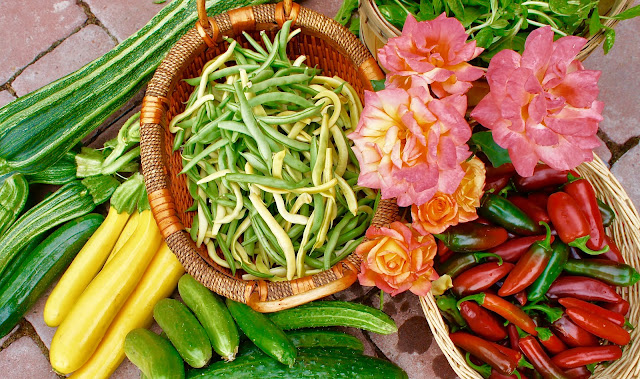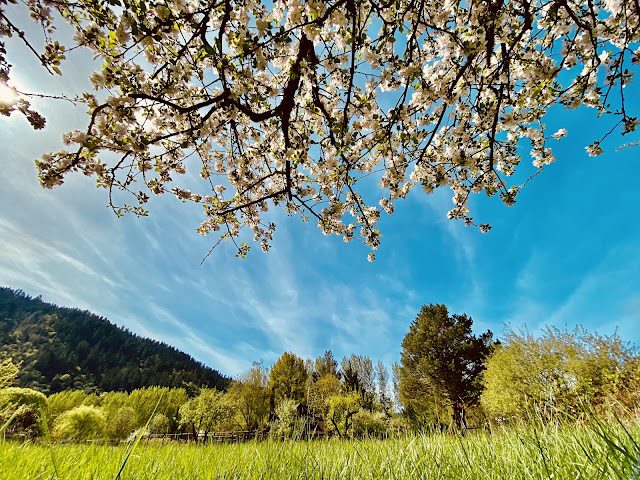Dear E-mail subscribers, please click the link to the blog website. The formatting in the email is all messed up.
With excessive loss and suffering here in rural Oregon and across the globe, writing about gardening and cooking seems irrelevant. Maybe irreverent. I try not to feel guilty about having had (not dead yet!) a lucky slide through the decades. Images of hungry children begging in foreign lands, and desperate humans even in small towns such as ours, holding "Stranded, Will work for food" signs haunt me. Measuring good and guilt is tricky.
But. When images of our pandemic garden flood my heart, I'm lifted. PK and I spend countless industrious hours out there, everything from harvesting tomatoes and peppers to picking cabbage worms off fall and winter crops, or deadheading flowers. The garden is ongoing work, which some may believe is unnecessary toil. Just shop the local farmers' markets, they say. Yes. Support those markets. But, if you have a bit of Earth to cultivate, consider the gladness of gardening. And the joy of sharing the bounty.
 |
| A homemade view filled with birds, bees, butterflies, and cheerful crowds of sunflowers. Salad in the sink coming right up! |
 |
| Salad in the sink for two right here. If you want to skip all the BS, scroll down to the recipe. Which you won't be able to print.
But it is so simple and savory you can remember, right? |
Sounds appetizing, eh? Salad in the sink?
It is actually a terrific way to use late-season zucchini and tomatoes and more. In truth, it is a salad served, ideally, from a colander in a sink, which may not be suitable for a fancy dinner party, but is useful for shoveling heaps of zukes and tomatoes from the seasonal avalanche onto salad plates.
During COVID at home with PK, it's a flavorful, fun, and easy-to-put-together first or only course. The man is flexible. He also does the dishes. And other useful things.
Assemble this concoction in a colander (a rectangular one is ideal) and serve from it too. I suppose if dinner guests (what are those?!) are coming, you could move it to a pretty bowl at the last minute.
The thing is, the zucchini spirals go into the colander first and are then generously salted before other stuff is added. Like proper dedicated athletes, the coils need to sweat for at least 20 minutes. Serving straight out of the colander saves the salad from being watery, plus it is a classy serving touch, don't you think?
Clean the sink first.
Even though summer officially gave way to fall on Sept. 21, our garden didn't get the news. The prolific plot continues to produce excessive zucchinis, beauteous tomatoes, and tender green beans, which are just coming on. Bring em!
The basil is confused about when to stop and hasn't. The Walla Walla onion in this simple salad was harvested in June and has been cool in the garage frig during the blistering summer along with its bloated brothers and sisters, some of which are 10 inches diameter. They had a diet of rich compost and now contribute sweet crunchiness to the salad in the sink.
 |
In addition to a zucchini 9-10 inches long, all you need are a few dead-ripe tomatoes, a generous handful of green beans, sweet onion, basil, salt, and Parmesan or fresh mozzarella cheese.
In recent years, I've gone big on spiralizing zucchini. Quick, easy, and delish. If you can imagine zucchini being delish. Maybe that's overstated. Palatable? Anyway, salting zuke "noodles" improve the bland vegetable's taste and texture and create a medium for savory sauces. |
 |
| With ends trimmed, this zuke is about 9 inches long. The Paderno World Cuisine spiralizer can handle about 10 inches. It also has blades to shred and slice other veggies or cheeses. Many competing brands exist, of course. This simple tool may set you back about $25. |
 |
| Spiralizing a zuke is quick and easy once you get the hang of it. You need a hard surface for the suction cups that keep the device in place. |

For the salad in the sink, snip the noodles, so you don't have to pretend you're making pasta. (Subbing zuke noodles for pasta recipes requires only a couple of snips.) For either use, salting produces the best results. How much? I don't measure, but I shake, shake, shake with gusto three or four times, then mix and let rest for at least 20 minutes, carefully stirring a few times. Despite using what seems like excessive salt, I've never had to rinse the noodles. They keep for days refrigerated, and I add them to other salads, soups, or stirfries.
I apologize for not having a "print" function, although a person could copy, paste, and print. I am an occasional blogger these days and got away from frequent recipe posting several years ago. Not that I had a print function even then.
RECIPE - Simple Summer Salad in the Sink
Ingredients for two - easy to ramp up for more mouths
- one firm medium/large (9-10 inches) zucchini, spiralized
- a big handful of fresh green beans, lightly steamed
- a cup or so of sliced sweet, crunchy onions like Walla Walla
- two or three firm garden tomatoes, such as Romas, Tasteilees, or whatever you have
- chunks or slices of fresh mozzarella or shredded Parmesan cheese, to taste
- salt for sweating operation
- fresh ground pepper to taste
- torn or whole fresh basil to taste
- salad dressing of choice
- a sprinkling of roasted salted pumpkins seeds for topping once the salad is plated
Directions
Spiralize the zucchini and dump into the colander in your sparkling clean, appetizing sink. Use scissors to snip noodles, so you're not dealing with spaghetti -lengths. Sprinkle the zucchini with salt, mix and let sweat for at least 20 minutes. Stir a time or two. Lots of water will be released. Taste before mixing with other stuff to make sure it's not too salty. If it is, rinse quickly with cold water. (I've never had to rinse.)
Cut the green beans into halves or thirds, then steam or boil until tender/crisp. Rinse with cold water and set aside. Cut the tomatoes into wedges, slice the onion, add fresh mozzarella chunks or slices, then gently mix all together. Top with fresh basil leaves, whole or torn.
After scooping the salad onto plates or bowls, apply your favorite salad dressing. I prefer my homemade sesame dressing, but if we've run out, I sub in vinaigrette or Annie's organic Fig Balsamic. We usually dress our individual salads. Sprinkle with shredded Parmesan, if using, and top with roasted pumpkin seeds, salted or not.
 |
| This is as fancy as it gets during COVID isolation. The sink salad this particular night was followed by deluxe grilled salmon filets and mustard roasted potatoes with a good Malbec. Thanks, Grace! |
 |
| A modest representation of the 2020 tomato and pepper harvests. |
 |
| One of many basil harvests. Much pesto is in the freezer for 2020-2021. |
 |
Zukes and green beans. Both prolific.
My teeth are getting green.
|
Interested in other salad and/or veggie recipes? I searched this blog for "salad dressing," and almost every salad recipe I've ever posted came up in this one link.
Earlier 2020 gardening post
Thanks for visiting. Good to be back!


















































